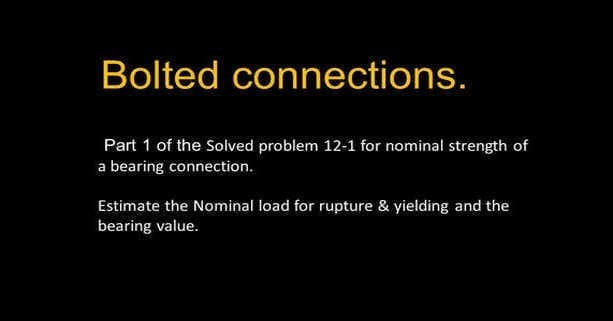Solved problem 12-1 for bearing connections.
A Solved problem for bearing connection 12-1-Part 1.
Our new topic will be the discussion of the solved problem 12-1 from Prof. McCormack’s book.
Determine the design strength φ*Pn and the allowable strength Pn/Ω for the bearing type connection shown in Fig.12-5. The steel is A36 where (Fy=36 KSi) and Fu=58 ksi, the bolts are 7/8″ in A325, the bolts are standard sizes, and the threads are excluded or X from the shear plane. Assume that deformations at bolt holes are a design consideration.
The overlap distance is length =9″, where the CL distance=3″ between bolts. The length is in the direction of the load, while the transverse cL distance =6″. The edge distance is 3″ and 3″ from each side.
Tensile Failure nominal load by Yielding for solved problem 12-1.
For this connection we have two modes of failure, the first mode of failure is due to yielding as shown in sec 1-1 and the mode of failure is to rupture as shown in sec II-II please refer to the next image for section 1-1.
We have a single-shear plane. Two plates are placed above each other and connected by 4 bolts. The bolts are 7/8″ where the area for each bolt=0.60 inch2 as given. And the upper plate is 1/2″, the lower plate thickness is 1/2″ and the plate width is given as 12″.
For the tensile yielding Fy to be multiplied by Ag, or the gross area. In the second case by tensile rupture, the area net is to be multiplied by Fult.
We are aware that, due to placing bolts during installation, we add 1/16″+1/16″ to be added to the diameter of one bolt which is 7/8″, then the final value considered for diameter=7/8+2*(1/16)=1″.
For the first case, the area gross=12*1/2=6 inch2. Then the tensile yielding =Ag* Fy, we have Fy=36 KSI and Fult=58 KSI, Ag=6 inch2, then Rn=Ag*Fy=36*6=216 kips, For the LRFD φ=0.90 φ*Rn=0.90*216=194.4 kips.
While for allowable design (1/Ω)*Rn, where Ω=1.67
Tensile Failure nominal load by rupture for solved problem 12-1.
For case b) where Area gross- 2*diameter*thickness of the plate. Anet =12*1/2- 2*(1))*1/2.Anet=5 inch2, since we are dealing with the net area then we use Fult, which is=58 ksi.Rn=5*58=290 kips.
Remember from the tension area lecture that Aeffective=U*Anet, U=1 for plates, then Aeff=1*5=5 inch2. But now φ=0.75, and Ω=2 .φ*Rn=0.75*290=217.50 kips. While Rn/Ω=290/2=145 kips.


The calculation of bearing for solved problem 12-1.
Prior to the procedure of checking the bearing capacity for the bolts, we need to have a look at the list of the necessary tables that we need to use in our estimation.
The diameter of bolts=7/8″, the hole diameter is the bolt diameter plus 1/16″, and the diameter hole equals 15/16″. The inner spacing=2 2/3 DB.
To check the requirement of the edge distance, there is Table J3.4 for a 7/8″ bolt, the required edge distance is 1/18″


To check the requirement of the edge distance, there is table J3.4 for dia 7/8″ bolt, the required edge distance is 1/18″.
This is a sketch showing the bolt spacing and edge spacing for a bearing connection.
We have a distance from cl to the outer edge=3″, the case is satisfied since this distance is >1 1/8″ as given by the table.
for the spacing requirements for inner bolts, the spacing value is 3 inches which is bigger than 2.33 inches which is the minimum requirement.
Nominal bearing value for the external bolts.
The next step is to estimate the nominal bearing value for the external bolts, we estimate the clear distance and it was found to be equal to 2.531 inches. We compare this value with the value of (2db). we find that the outer clear distance for the exterior bolt is bigger than 2db, which indicates that the nominal value is governed by the upper limit equation which is(2.4*d*t*fu). The details of the estimation can be found on the next slide.
Nominal bearing value for the inner bolts.
We will estimate the nominal bearing value for the inner bolts, we estimate the clear distance and it was found to be equal to 2.06 inches. We compare this value with the value of (2db). We find that the outer clear distance for the exterior bolt is bigger than 2db, which indicates that the nominal value is governed by the upper limit equation which is(2.4*d*t*fu). The details of the estimation can be found on the next slide.
The upper limit is 2.4d*b*t*Fult, db=7/8″ *t=1/2 for a plate, which is common between the left and right sides of the equation.
The upper limit value will be equal to 2.4*7/8*1/2*58=60.90 kips. The nominal load based on the equation (1.2*lci*t*fu) is shown and as we can see it is higher than the upper limit and is not considered in the design.
Nominal strength value for bolts.
The next step is to estimate the shear strength of the bolts. There are two ways to estimate the first way is to use table J3.2 and get the Fnv based on the type of bolt.in our problem, the bolt is 7/8 inch X type A. Fnv value is 68 ksi as single shear value for one bolt.
I have included two sketches as a comparison between the bolt’s nominal loads in bearing and the corresponding bolts but with the shear strength and it can be seen that the shear strength of bolts is less than the nominal load due to bearing and shear strength control the design.
We will continue the next post to finalize the calculations for the given connection. Thank you.
The next post will be A solved problem 12-1-part 2-connection nominal load.
A useful link-A Beginner’s Guide to the Steel Construction Manual, 15th ed, Chapter 4 – Bolted Connections

